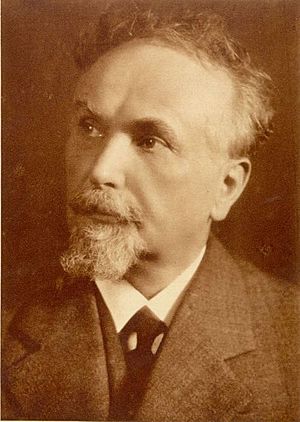Ivan Regen facts for kids
Quick facts for kids
Ivan Regen
|
|
|---|---|
 |
|
| Born | December 9, 1868 Lajše, Austria–Hungary (now Slovenia)
|
| Died | July 27, 1947 (aged 78) |
| Nationality | Slovene |
| Alma mater | University of Vienna |
| Known for | establishing modern bioacoustics |
| Scientific career | |
| Fields | animal physiology, bioacoustics, geobiology |
| Academic advisors | Karl Grobben, Sigmund Exner, Carl Friedrich Wilhelm Claus |
| Influences | Karl Grobben |
Ivan Regen (also known as Janez Regen or Johann Regen) was a famous Slovenian biologist. He was born on December 9, 1868, and passed away on July 27, 1947. He is most famous for his work in bioacoustics. This is the study of how animals make and hear sounds, and how they use sounds to communicate.
Contents
Early Life and Education
Ivan Regen was born in a small village called Lajše, which is now part of Slovenia. His mother really encouraged his interest in the sounds that insects make.
Even though his family faced money problems, Ivan was very smart. He received a special scholarship to attend a local school. This helped him save enough money to study in Vienna, the capital of Austria.
At the University of Vienna, he studied natural history. He learned from important teachers like Karl Grobben, Sigmund Exner, and Carl Friedrich Wilhelm Claus. In 1897, he earned his doctorate degree. After that, he worked as a school teacher in Vienna and later in Hranice. Eventually, he returned to Vienna to teach at a secondary school until he retired in 1918.
Groundbreaking Research on Insects
Ivan Regen was one of the first Slovenian scientists to work in another country after World War I. He started studying insects in great detail. He was especially interested in how they make and hear sounds.
Understanding Insect Communication
Regen was the first scientist to study grasshoppers very closely. He focused on the sounds made by katydids and crickets. He proved that insects actually react to sounds made by other insects.
He even managed to make crickets react to artificial sounds using a loudspeaker. In one amazing experiment, he used a telephone to send cricket sounds from one room to another. This showed how sensitive their hearing was!
Discovering the Ear Drum's Role
Later, Ivan Regen showed that insects hear using their ear drums. He was the first person to figure out exactly what the ear drum does for insects. Because of his discoveries, he is known as the person who started the modern study of bioacoustics.
Besides sounds, he also studied other things about insects. He looked at how they breathe, how they hibernate (sleep through winter), their colors, and how they shed their skin.
The Geobiological Laboratory
Regen's biggest project was his "geobiological laboratory." This was a large glass cage, like a giant terrarium. He used it to study how crickets could find other crickets using sounds. This behavior is called phonotaxis.
He conducted experiments with up to 1600 female crickets. Some had normal hearing, while others had damaged hearing. This helped him understand exactly how they used sound to find each other.
Later Life and Legacy
After 1911, Ivan Regen worked on his own research. However, he also supported many groups and organizations in Slovenia. He even started using Slovene words for scientific terms in his field.
In 1921, he was offered a job as a professor at the University of Ljubljana, but he decided not to take it. In 1940, he became a member of the Slovenian Academy of Sciences and Arts. He was also a member of the Slovenian Society of Natural History.
Even though he was a world-famous scientist, Ivan Regen lived a simple life and was not wealthy. The Austrian Academy of Sciences helped pay for his experiments, but he was never allowed to become a member himself. He did all his important work from his home. Sadly, after he passed away, much of his special equipment, like microphones, oscilloscopes, and his written notes, were destroyed.
See also
 In Spanish: Ivan Regen para niños
In Spanish: Ivan Regen para niños

